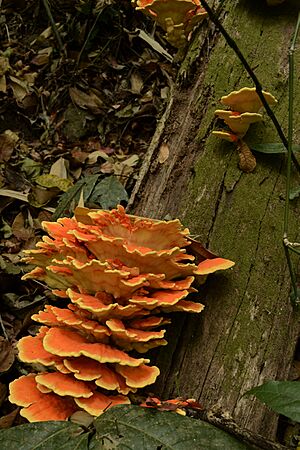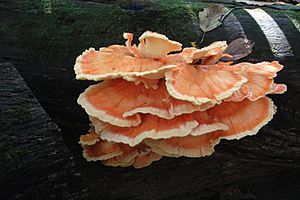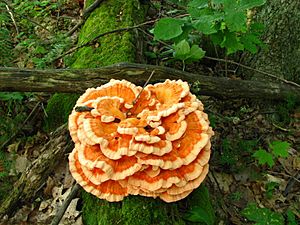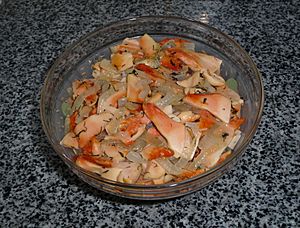Laetiporus facts for kids
Quick facts for kids Laetiporus |
|
|---|---|
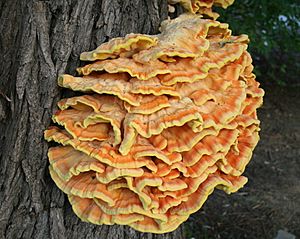 |
|
| Laetiporus sulphureus in Belgium | |
| Scientific classification |
|
| Kingdom: | Fungi |
| Division: | Basidiomycota |
| Class: | Agaricomycetes |
| Order: | Polyporales |
| Family: | Fomitopsidaceae |
| Genus: | Laetiporus Murr. (1904) |
| Type species | |
| Laetiporus speciosus Battarra ex Murrill (1904)
|
|
Laetiporus is a group of edible mushrooms found in many parts of the world. Some types, especially Laetiporus sulphureus, are often called sulphur shelf or chicken of the woods. People call them this because they taste and feel a lot like chicken meat. But be careful! "Chicken of the woods" is different from other mushrooms like Maitake or the "fried chicken mushroom." The name Laetiporus means "with bright pores," which describes their look.
Contents
What Does Laetiporus Look Like?
Each "shelf" of this mushroom can be from 5 to 25 centimeters (2 to 10 inches) wide. These shelves are made of many tiny tubes. The mushroom grows in large groups, sometimes weighing over 45 kilograms (100 pounds)! That's super heavy for a mushroom!
You'll often find Laetiporus growing on injured parts of trees. It likes oak trees the most, but it can also grow on eucalyptus, yew, sweet chestnut, and willow. Some types even grow on conifer trees like firs. Laetiporus mushrooms are parasites. This means they live off the tree, causing a type of decay called brown rot. This rot can make the tree weak over time.
When they are young, these mushrooms are moist and rubbery. They are usually a bright sulphur-yellow or orange, sometimes with bright orange tips. As they get older, they turn pale and brittle, almost like chalk. They might also have small holes from beetles or slugs.
There are similar types, like Laetiporus gilbertsonii (which is pink) and L. coniferica (found on fir trees in the western United States). Most Laetiporus species are thought to be safe to eat, but it's always good to be careful.
Where and When Does It Grow?
The sulphur shelf mushroom can grow back year after year if the weather is right. It grows best from late spring to early autumn. This makes it exciting for mushroom hunters! But for tree owners, it can be a problem. This fungus causes the tree's wood to rot and become brittle. In the end, the tree might even fall down because it can't bend in the wind anymore.
You can find chicken of the woods growing on or at the bottom of dead or dying hardwood trees. Oak, cherry, and beech trees are common hosts. It can also grow on dead conifer stumps. Sometimes, it even grows on living trees.
How Scientists Study Laetiporus
Scientists use special tests to understand how different Laetiporus mushrooms are related. They look at the mushroom's DNA to group them into different families, called "clades." For example, some types that grow on conifer trees are in one group. Other types, like L. cincinnatus or L. sulphureus, are in different groups. These studies help us learn more about the many kinds of Laetiporus mushrooms found around the world, including in Japan, Hawaii, Europe, and South Africa.
Can You Eat Laetiporus?
Yes, you can eat Laetiporus mushrooms! Many people say they taste like chicken. You can cook them in many ways, just like you would chicken meat. They are also a great choice for vegetarians who want a chicken substitute. You can even freeze them for a long time, and they will still be good to eat. In some places, like parts of Germany and North America, they are considered a special treat.
However, some people might have mild reactions after eating this mushroom. This could include things like swollen lips or, rarely, feeling sick to your stomach or dizzy. This might happen if someone is sensitive to certain things in the mushroom. Because of this, many experts suggest being careful. If you try Laetiporus, make sure it's fresh and young. Start by eating only a small amount to see how your body reacts.
Interestingly, Laetiporus sulphureus can help stop the growth of some bacteria, like Staphylococcus aureus.
Different Kinds of Laetiporus
Here are some of the different species (types) of Laetiporus mushrooms:
- Laetiporus ailaoshanensis B.K.Cui & J.Song (2014)
- Laetiporus baudonii (Pat.) Ryvarden (1991)
- Laetiporus caribensis Banik & D.L.Lindner (2012)
- Laetiporus cincinnatus (Morgan) Burds., Banik & T.J.Volk (1998)
- Laetiporus conifericola Burds. & Banik (2001)
- Laetiporus cremeiporus Y.Ota & T.Hatt. (2010)
- Laetiporus discolor (Klotzsch) Corner (1984)
- Laetiporus flos-musae Overeem (1927)
- Laetiporus gilbertsonii Burds. (2001)
- Laetiporus huroniensis Burds. & Banik (2001)
- Laetiporus miniatus (P.Karst.) Overeem (1925)
- Laetiporus montanus Černý ex Tomšovský & Jankovský (2009)
- Laetiporus persicinus (Berk. & M.A.Curtis) Gilb. (1981)
- Laetiporus portentosus (Berk.) Rajchenb. (1995)
- Laetiporus squalidus R.M.Pires, Motato-Vásq. & Gugliotta (2016)
- Laetiporus sulphureus (Bull.) Murrill (1920)
- Laetiporus versisporus (Lloyd) Imazeki (1943)
- Laetiporus zonatus B.K.Cui & J.Song (2014)
See also
 In Spanish: Laetiporus para niños
In Spanish: Laetiporus para niños


